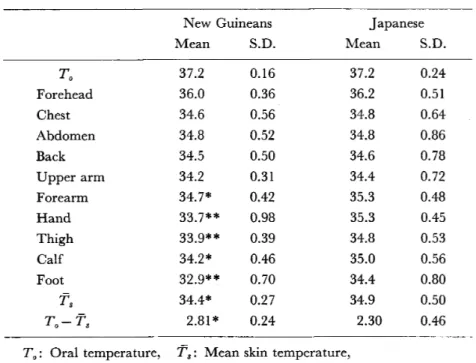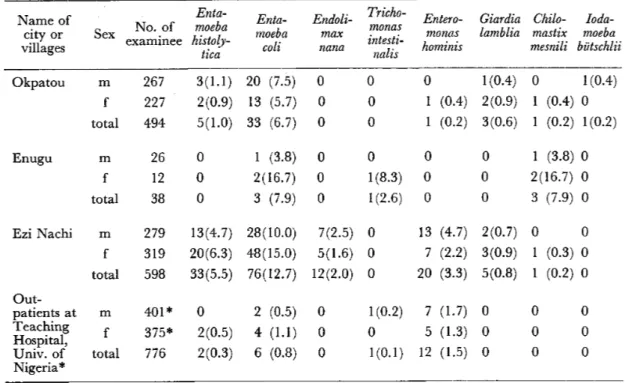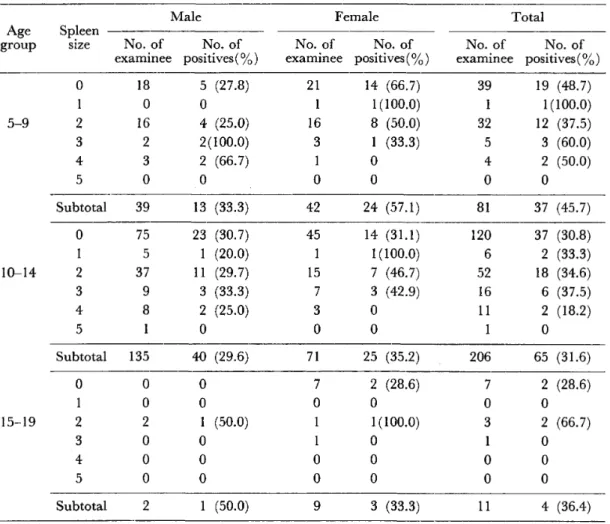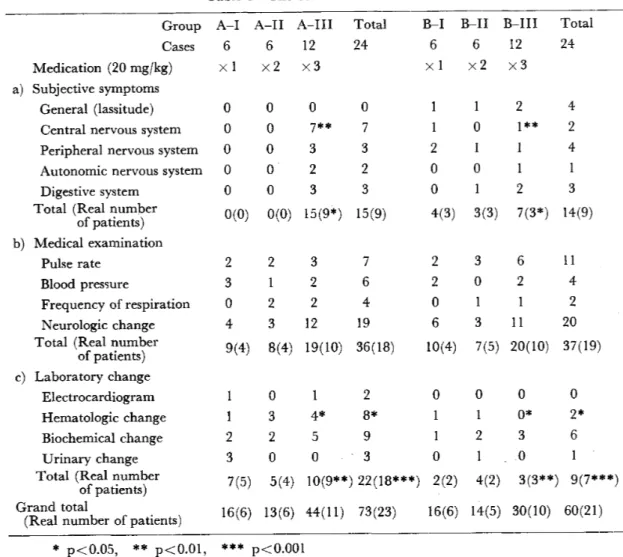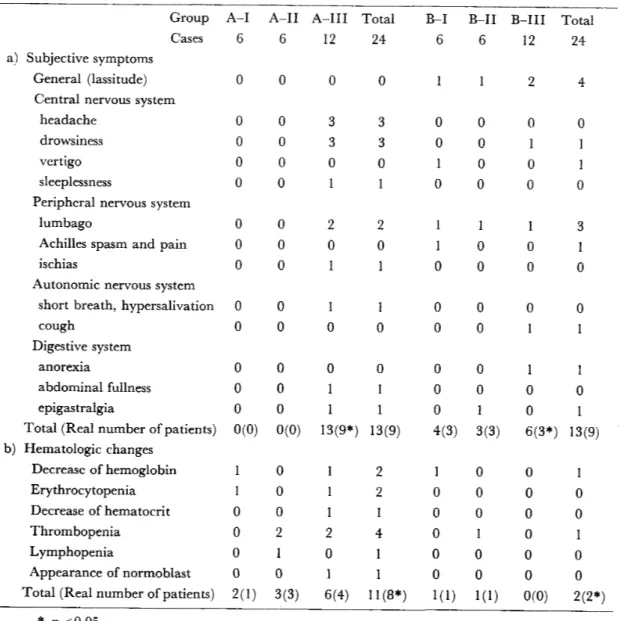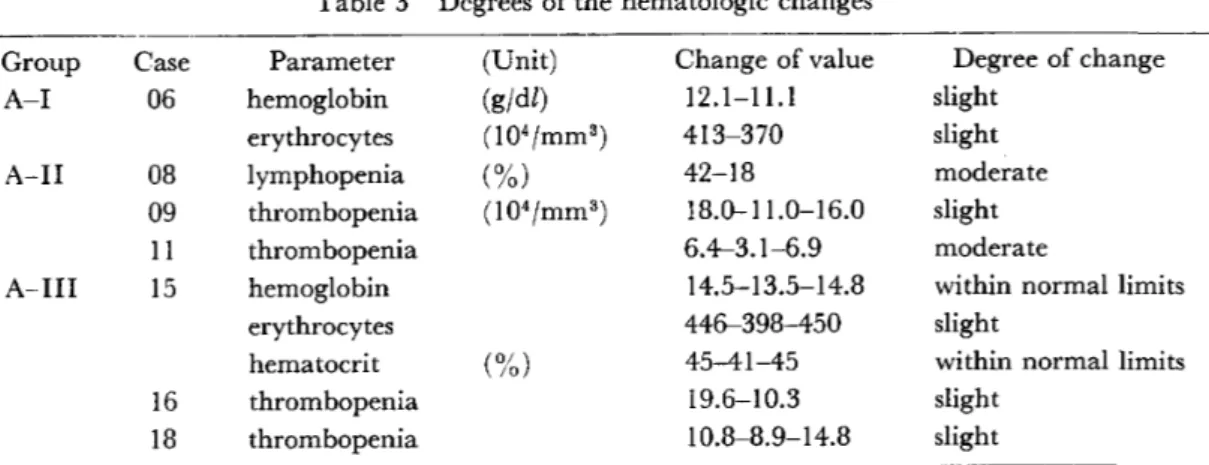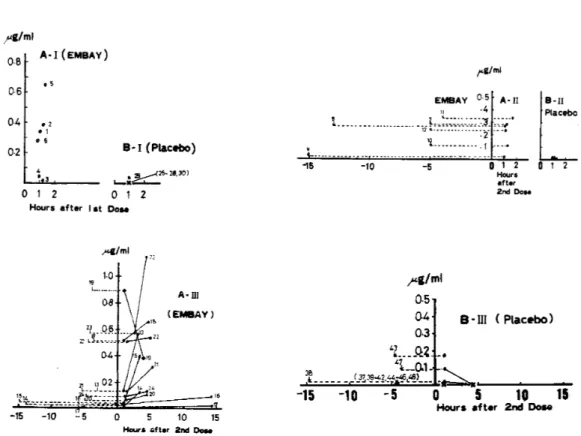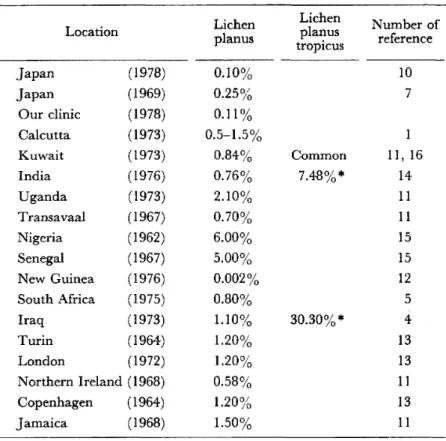第7巻第1号 昭和54年6月15日
内 容
原 著
中和温域におけるパプア・ニューギニア人と日本人の体温の比較(英文)
・辻田 純三,伊藤 清臣,黛 誠,田中 信雄,堀 清記 1−6 ナイジェリア連邦共和国東中央州エヌグ市周辺地区における寄生虫調査
…山本 久,A.A.N.U.Njoku・Obi,F.αChukwuma,
1.Ugwuegblam,E.Ahumibe 7−21 日本住血吸虫症に対するEMBAY8440(Praziquante1)の臨床的使用経験(英文)
・加茂 悦爾,石崎 達23−33
熱帯性扁平苔癬にっいて
・小澤 明,松尾 皐朗,新妻
町田
寛,鈴木 弓,
暁,大城戸宗男35−42 正常ガーナ人における骨濃度の測定
・・黒羽根洋司,中村 武,松本 淳,Ofusu・Amaah43−49
会 則一
投稿規定一
会員名簿・・
・51−54
・55−56
・57−83
日熱医会誌
JapanJ.T.M.H. 日 本熱帯医学会
COMPARISON PAPUA
IN
OF BODY TEMPERATURES BETWEEN NEW GUlNEANS AND JAPANESE
A WARM ENVIRONMENT
JUNZO TSUJITA, KIYOOMI ITO, MAKOTO MAYUZUMI, NoBUO TANAKA AND SEIKI HORI
Received for publication 13 November 1978
Abstract: Measurement of oral and skin temperature at ten sites was made on I l young male New Guineans, ages 19‑24, in Port Moresby in September, 1978 and 15 young male Japanese, ages 19‑22, in Japan in September while sitting in a chair at rest in a room maintained at 28.0 C with 70.0 per cent relative humidity.
Both groups showed the same oral temperature (37.2 C). New Guineans showed a lowcr mean skin temperature (34.4 C) than Japanese (34.9 C).
Skin temperature in the extremities was significantly lower for New Guineans than for Japanese, and thermal heterogeneity ofskin surface for New Guineans was greater than that for Japanese in a warm environment. The differences in skin temperatures measured were discussed in view of physiology of acclimatization to hot environments.
INTRODUCTION
Unacclimatized subjects are lirnited in the amount of task they can perform in hot environments (Robinson et al., 1943). When unacclimatized individuals are repeatedly exposed to a hot environment, adaptive changes in physiological responses to heat occur, and acclimatized individuals can perform a task with less of cardio‑
¥'ascular strain, Iower rise in body temperature and less fatigue (Tailor et al., 1943;
Bass, 1963 ; Piwonka et al., 1965). Although many studies have been made on adaptive changes in sweating during heat acclimatization of men (Adolph, 1946;
Christensen, 1946; Eichna et al., 1950), very little attention has been given to the adaptive changes in adjustment of skin temperature during acclimatization to heat (Robinson, 1949; Kuno, 1956). Heat produced in the body is dissipated by radia‑
tion, convection and evaporation of water. Since body ternperature of resting men at temperature below 29 C is adjusted by heat dissipation without sweatipg, and heat dissipation by radiation and convection is proportional to the difference between skin temperature and ambient temperature, the ability of heat dissipation without sweating is dependent on capacity of raising mean skin temperature with a rise in ambient temperature. Papua New Guinea, Iocated in a tropical zone, has a hot climate throughout the year, whereas Japan, Iocated in a temperate zone, has a hot summer and a cold winter. New Guineans, therefore, are expected to be more acclirnatized to heat than Japanese. Thus an attempt was made to compare body
The First Department of Physiology, Hyogo College of Medicine, Nishinomiya.
temperatures, particularly skin temperatures of New Guineans in a warm environ‑
ment, with those ofJapanese.
MATERIALS AND METHODS
Two series of experiments were performed. The flrst series of the experiment was performed in September 1978 on 1 1 young male Papua New Guineans, aged 19‑24 years old, in Port Moresby, Papua New Guinea. The second series of the experiment was performed in September on 1 5 young male Japanese, aged 1 9‑22 years old, in Nishinomiya, Japan. The mean air temperature and relative humidity in September in Port Moresby were 26.5 C and 73.0 per cent, respectively, and those in Nishinomiya were 23.1 C and 74.0 per cent, respectively. Experiments were carried out at around 1 1 : OO a.m. in order to minimize circadian rhythm of body temperature. The subjects were instructed to fast and remain at rest in a room with a temperature of 28.0 C and 70.0 per cent relative humidity, while oral and skin temperatures of each subject clad only in shorts in sitting position was measured. Oral temperature was measured with a clinical thermometer and skin temperatures were measured with a pyrometer.
Cutaneous sites for the measurement of local skin temperatures and weighing factors used for calculating the mean skin temperatures are as follows (Kikdseirihan,
1952) :
Forehead Chest Abdomen Back Upper arm Forearm Hand Thigh Calf Foot 0.098 0.083 0.162 0.083 0.082 0.061 0.053 0.172 0.134 0.072
The skinfold was measured at the back of the upper arm and under the angle of the scapula. The measurement was read 2 seconds after the full pressure of the caliper jaw was applied to the skinfold. Body surface area (S in m2) was calculated from height (H in cm) and body weight ( W in kg) using the following formula of Takahira :
S=0.007246 x Wo. 425 >< Ho. 725
RESULTS
Mean values and standard deviations for age, height, body weight, body surface area, girth of chest, girth of upper arm and girth of thigh and skinfold thickness of
Table I Characteristics of subjects
S.T.
Group Number Age Height Wt B. S .A. G. C . G.A. G.T. (mm) (yr) (cm) (kg) (m2) (cm) (cm) (cm) Tri. Sub.
New Guineans 1 1 l:8 7.5 14.2 Japanese 1 6 20.3 1 69.8 63. l 0.6 5.0 8 7
20.2 169.4 64.4 1 75 88 7 27 3 47 4 8 6 12 6 0.20 6.5 2.8 4・ I 6.8 7.5
l . 74 88.2 25 .9 49.4 1 0.6 9,4 0.13 5.3 2.6 12.3 2.3 3.l
Wt: Body weight, B.S.A. : Body surface area, G.C.: Girth of chest, G.A.: Girth of upper arm, G.T.: Girth of thigh, S.T.: Skinfold thickness, Tri.: Triceps, Sub.: Subscapular, Mean values are given with their standard deviations.
New Guineans and Japar!̲ese are presented in Table I . Both groups showed essen‑
tially the same physical status. The mean values and standard deviations of oral temperature ( T.), skin temperatures at 10 sites, mean skin temperatures (T.) and the difference between T. and T* are shown in Table 2. The mean values of oral temperature were identical, 37.2 C, for both groups. All the mean values of local skin temperatures except temperature on the abdomen for New Guineans were smaller than those for Japanese. Among these values the mean values of local skin temperature on the forearm, hand, thigh, calf and foot were significantly smaller for New Guineans than for Japanese. Both groups showed the sarne mean value of 10cal skin temperature on the abdomen 34.8 C. T'hus it can be said that local skin temperatures in the extremities for New Guineans are lower than those for Japanese when compared with skin temperatures in the trunk and thermal heterogeneity of the skin surface for New Guineans is greater than that for Japanese. New Guineans showed considerably lower mean value of mean skin temperature (34.9 C) than Japanese (34.4 C). The mean value of the T.‑T, gradient for New Guineans (2.81 C) was greater than that for Japanese (2.30 C). These differences, however, were statistically not significant.
DISCUSSION
A resting man, clad only in shorts, in a warm environment (28.0 C) Ioses about 70.0 per cent of his body heat by radiation and convection while heat dissipation by evaporation of water is about 30.0 per cent of the metab.olic heat (Gagge et al., 1938).
Heat dissipation by both radiation and convection is proportional to the ternperature gradient between skin surface and air. As shown in Table 2, the mean value of mean skin temperature ( T.) for New Guineans (34.4 C) was smaller than that for Japanese (34.9 C). This lower T, for New Guineans indicates T.‑T (ambient temperature) gradient for New Guineans was smaller than that forJapanese. There‑
fore, the amount of heat dissipation under the experimental condition used in this experiment was smaller for New Guineans than that for Japanese. Body heat must be dissipated at the same rate of heat production in the body to keep a constant body temperature, and several investigators reported that basal metabolism decreased with the increase in monthly mean ambient temperature (Nakamura et al., 1969;
Ogata and Sasaki, 1975 ; Hori et al., 1977). Thus lower T, for New Guineans might reflect a lower basal metabolism of New Guineans due to higher monthly mean ambient temperature in Papua New Guinea.
As shown in Table 2, skin temperature in the extremities for New Guineans was significantly lower than that for Japanese while skin temperature in the trunk for New Guineans was slightly lower than that for .Iapanese and the heterogeneity of skin temperature for New Guineans was much greater when compared with that for Japanese. It is well known that a rise in skin temperature in the extremity with increasing ambient temperature in a warm environment is greater than that in the trunk, and thermal heterogeneity of the skin surface is progressively reduced with increasing ambient temperature. It may be assumed that skin temperature,
Table 2 Oral temperature and skin temperatures New Guineans
Mean S.D.
Japanese
Mean S.D.
T.
Forehead Chest
Abdomen Back Upper arm Forearm
Hand
Thigh Calf Foot Ts
T.‑T*
37.2 36.0 34.6 34.8 34.5 34.2 34.7*
33.7**
33.9**
34.2*
32.9**
34.4*
2.81 *
O. 1 6
0.36 0.56 0.52 0.50
0.3 l 0.42 0.98 0.39 0.46 0.70 0.27 0.24
37.2 36.2 34.8 34.8 34.6 34.4 35.3 35.3 34.8 35.0 34.4 34.9 2.30
0.24 0.51 0.64 0.86 0.78 0.72 0.48 0.45 0.53 0.56 0.80 0.50 0.46 To
*
Oral temperature, Ts : Mean skin temperature,
Significant difference between New Guineans and Japanese per cent level* and O. I per cent level**.
at one
particularly skin temperature in the extremity, can rise easily when New Guineans are exposed to a hotter environment, while skin temperature can be increased less and sweating occurs earlier than in New Guineans when Japanese are exposed to a hotter environment (Hori et al., 1977). Indeed, a longer latent period of sweating was observed in natives in the tropical zone when compared with Japanese born and raised in Japan, Iocated in the temperate zone (Kuno, 1956).
Table 2 shows that the mean value of the T.‑ f, gradient (2.30 C) was con‑
siderably greater for New Guineans than that for Japanese. Metabolic heat pro‑
duced in the body is transferred by the cardiovascular system from core to shell, and the T.‑T, gradient is approximately inversely proportional to the coefficient of heat conductance of the body. Thus, the coefflcient of heat conductance might be lower for New Guineans than for Japanese under the condition used in this experiment.
Eichna et al. (1950) reported also that the temperature gradient between core and shell increased as man acclimatized to heat. Since skin temperature in the extremities for New Guineans can rise more easily than that for Japanese in a hotter environment, the coefficient of heat conductance for New Guineans might increase more rapidly with a rise in ambient temperature than that for Japanese. From the above account, superior capacity of raising mean skin temperature and increasing coeflicient of heat conductance of body with a rise in ambient temperature for New Guineans could be considered as one of the most important adaptative changes in physiological response to h.eat during heat acclimatization.
ACKNOWLEDGEMENT
Authors express out tke experirnent, the experiment.
their thanks to Dr. Y. Sato of W.H.O. for his help
and also to Prof. H. Koishi for his encouragement m carrymg
throughou t
This work was Science and Culture
partly supported by a grant from the Ministry of Japan.
of Education,
REFERENCES
1) Adolph, E. F. (1946) : The initiation of sweating in response to heat, Am. J. Physiol., 145,
7 1 0‑7 1 5
2) Bass. D. E. ( 1963) : Thermoregulatory and circulatory adjustments during acclimatization to heat in man. Temperature, Its Measurement and Control, 3, 299‑305, Reinhold. New York 3) Christensen, W. R. (1947) : Long term acclimatization to heat. Am. J. Physiol., 148, 86‑90 4) Eichna, L. W.. Park, C. R., Nelson, N., Horvath. S. M. and Palmes. E. D. ( 1950) : Thermal
regulation during acclimation in a hot dry (desert type) environment, Am. J. Physiol., 163, 585‑597
5) Gagge, A. P., Winslow, C. E. A. and Herrington, L. P. (1938) : Influence cf clothing on physio‑
logical reactions of human body to varying environmental temperatures. Am. .J. Physiol., 124, 30‑50
6) Hori, S., Ohnaka, M., Shiraki, K., Tsujita, J., Yoshimura, H., Saito, N. and Panata, M. (1977) : Comparison of physical characteristics, body temperature and basal metabolism between Thai and Japanese in a neutral temperature zone, Jap. J. Physiol., 27, 525‑538
7) Kikdseirihan, Research Committee on physiological reaction to climatic seasonal change (1952) : Seasonal variatioris of skin temperature distribution of Japanese male adults, Nisshinigaku, 39, 120‑136 (in Japanese)
8) Kuno, Y. (1956) : Hurnan perspiration, Charles C. Thomas, Springfield, Ill.
9) Nakamura, M., Usutani, S.. Horimae, T, and Sugawara, K. ( 1969) : Local specificity of the seasonal variation in the basal metabolic rate ofJapanese, Tohoku J. Exp. Med., 99, 1 71‑178 lO) Ogata, K. and Sasaki. T. ( 1975) : Regional differences in the cold adaptability of the Japanese
in physiological adaptability and nutritional status of .Japanese, Chapt. 2. Part l, in JIBP Synthesis Vol. 3. ed. by Yoshimura, H. and Kobayashi, S., Tokyo Univ. Press., Tokyo
1 l) Piwonka, R. W., Robinson, S., Gay, V. L. and Munard, R. S. (1965) : Preacclimatization of men to heat by training, J. Appl. Physiol., 20, 379‑384
12) Robinson, S. ( 1949) : Physiological adjustment to heat. In: Physiology of Temperature Regu‑
lation and the Science of Clothing, ed. by Newburgh, L. H., Saunders, Philadelphia, pp. 193‑231 13) Robinson, S., Turell, E. S. and Gerking, S. D. ( 1949) : Physiological equivalent conditions of
air temperature and humidity, Am. J. Physiol., 143, 2 1‑32
14) Taylor. H. L.. Henschel, A, and Keys, A. ( 1943) : Cardiovascular adjustment of men in resi and work during exposure to dry heat, Am. J. Physiol., 139, 583‑591
中和温域におけるパプア・ニューギニア人と日本人の体温の比較 辻田純三・伊藤清臣・黛 誠・田中信雄・堀 清記
1978年9月にパプア・ニューギニアのポートモレスビーにおいてパプア・ニューギニア人の成人男 子11名及び西宮市において日本人成人男子15名にっいて28C,湿度70%の室内にて水泳パンッのみを 着用させ,安静座位における口内温と全身10ヵ所の皮膚温を測定して次のような結果を得た。
口内温は両群とも37.2Cであった。パプア・ニューギニア人の平均皮膚温は34.4Cで日本人の平 均値349Cよりかなり低く,従ってパプア・ニューギニア人の口内温と平均皮膚温の差は日本人の それより大きく,中和温域においては,パプア・ニューギニア人の身体の熱貫流率は日本人のそれよ り小さかった。パプア・ニューギニア人の四肢の皮膚温は日本人のそれより有意差をもって低かった。
その結果としてパプア・ニューギニア人の皮膚温の部位別の差は日本人のそれよりかなり大きく,環 境温がさらに上昇したとき,パプア・ニューギニア人の四肢の皮膚温上昇は日本人より容易で,皮膚 温調節による放熱量の調節能力が優れていることが推定された。
兵庫医科大学第一生理学講座
ナイジェリア連邦共和国東中央州エヌグ市周辺地区に
おける寄生虫調査
山本久1,A.A.N.UNjoku−Obi2,EO・Chukwuma2,
1.Ugwuegblam2,E.Ahumibe2 昭和53年9月5日 受付
ナイジェリア連邦共和国は,西アフリカの北緯
4。20 一14。0 ,東経2。40 一14。20〆に位置し,国の南
北は約700km,東西約900kmの矩形状を呈し,
その面積は本邦の約2.5倍の,923,416km2を有し,
人口約5,500万を擁する。気候,風土はその南北 で著しく異なる。即ち,北部はサハラ砂漢南端に つらなり,南に向って草原及び森林サバンナ,熱 帯降雨林となる。海岸線から20〜90kmは雨量 の多いマングローブ湿地帯である。
この国内に200余の部族があり,それぞれ特有 の歴史,文化をもつ。このうち,ヨルバ族が国の 西南部,イボ族が東部,ハウサ族は北部地方に多 く,この三部族が全人口の約70%を占める。本報 告の東中央州はイボ族で占められ,その90%以上 はキリスト教徒である。
古くからこの地は各種熱帯病の蔓延の地として 恐れられてきた。各種寄生虫病も多く,マラリア,
糸状虫症,腸管寄生原虫症が多いと報告されてい るが,詳細については殆ど知られていないのが現 状である。
本報で報告する調査地区であるエヌグ市(人口 約15万人とされている)の周辺では今なお山焼 農耕を行っており,原始的な農耕に頼っているの が実状で政府関係者は農業の近代化に力を注いで いる。市の中心部には電気,水道などの設備があ るが,正常に機能しているのはごく一部で,著者 の滞在中,大学病院内で水道の供給があったのは 全期間を通じて1/4に満たなかった。多くは石油 ランプを用い,水道は共同の簡易水道が市中の要 所に設けられている。エヌグ市を出てしまうと,
これらの設備は勿論なく,地域住民の生活は窺う べくもない。著者の一人山本は1974年に約1年間
この地に滞在し,寄生虫類の調査研究に従事した。
本報ではその結果の一部を報告する。
方 法
検査材料は次の通りである。
1) ナイジェリア大学医学部附属病院で外来及 ぴ入院患者について随時行われている検便検査
(直接塗抹法1枚)の1974年についての結果を集 計したもの,2)エヌグ市より北西約30kmに位 置する村落Okpatou(オパトウと発音する)の住 民について検査したもの,3)エヌグ市の南約 100kmのEzi Nachiの住民について検便したも
の,4)エヌグ市内中心部の住民について採便し たもの,以上についての検査法は18×18mm角 カバーグラスを用いた直接塗抹一枚法,ルゴール 液を用いた塗抹標本一枚法によって,蠕虫卵,原 虫類を調べた。浮遊法は硫苦食塩水を用いて,2),
3),及び4)の一部検体にっいて行った。沈殿法は 3)地区についてはAMS−III法を行った。その他 の地区では必要に応じてMGL法を併用した。ま た濾紙培養法を随時行って鉤虫の種の同定,及び 糞線虫の同定を行った。
また2)地区については学童を対照として,ス コッチテープ法による嶢虫検査を行った。本地区 の学童については,血液塗抹標本によるマラリア 感染の状況を調ぺ,併せてSpleen sizeとの関連 について観察を行った。
1獅協医科大学医動物学教室
2ナイジェリア大学医学部微生物学教室
N工GER Lake Chad DAHOMEY
North−Western
North−
Cen亡ral l Kan・
曳aria
Nor th−Eas tern
Ckaduna
Kwara
Western
亀fe 避badan
♂ag・S
Bight of Benin
Benue−
Plateau
Eas亡一 Centralが・甑
γ
SOuth−
Eastern
River Niger
M霊!n n魁nugu West
Rivera
CAMEROUN
Figure l Map ofthe Federal Republic ofNigeria in1974.
結 果
1.蠕虫類
ナイジェリア大学医学部附属病院における外来 患者の1974年1〜3月期の総数776名(性別,年齢 の明瞭なものに限った)の検査結果を第1表に,
エヌグ市郊外のOkpatouの住民総数494名(性別,
年齢の明瞭なものに限った)についての結果を第 2表に,Okigwi地区のEziNachiの住民総数598 名(性別,年齢の明瞭なものに限った)について の結果を第3表に,エヌグ市内の住民38名につい ての結果を第4表に示した。また上記4地区の全 体をまとめた結果を第5表に示した。4群に共通 して言えることは鉤虫(すべてアメリカ鉤虫で あった)の感染率が極めて高いこと,回虫,鞭虫 の感染率が意外に低いことであった。糞線虫は地
区によって著しく高率に見出され,また肺吸虫は Ezi Nachiにのみ見られた。大学病院外来患者は 比較的若年層に集中しているが,各年代にわたっ ている。鉤虫は他地区に比し著しく低い感染率を 示している。回虫は0〜19歳までの年齢層に集まっ ているほか糞線虫が若年齢層に集中して見出され ている。また無鉤条虫が男女各1例ずつ見られた。
本条虫はエヌグ市内からも1例認められた。
Okpatouでは鉤虫の感染率が全年齢層に対し平 均64.6%と言う高い感染がみられた。糞線虫は 平均3.2彩であったが5〜14歳の若い年齢層にそ の過半数がみられた。一方スコッチテープ法によ る嶢虫検査を行ったが平均3.4%と意外に低く 5〜14歳の年齢層に集中して見出された。
Ezi Nachiでは鉤虫感染がOkpatouと同様に 60.0%と極めて高い値を示した。また本地区は 糞線虫の感染が大変高く平均28,1鰯を示し,それ
5‑19 a) f iC ; L < Fp L ‑‑ !. ) tL / . ; :i Paragonimus uterobilateralis a) f '4 "T ti 1F 15.4 ) , I ) tL :. H i : I 1 ) ! l ( : V* !J 5‑14 :a) i
eC FF L ; h tL fc.
I /: : : i ! : l I ; . Capillaria sp.
1 , FR j : ; 6i ; :, ;tLf*‑. FR j! L l F 1 130‑150x80 p a)j ! i 7 :V> L Table l Frequency distribution of intestinal
patients visited Teaching Hospital, period from .January to March 1974
parasites University
(Helminths) by age among out‑
of Nigeria, Enugu, during the
Age group
No. of Ascaris
Sex examinee lumbricoides americanus Neca to r
Trichuris trichiura
Strongvloides Enterobius Taenia stercoralis vermicularis saginata 0‑4
5 ‑9
l O‑ 1 4
l 5‑ 1 9
20‑24 25‑29 30‑34 35‑39 40‑44 45‑49 50‑54 55 59 60‑64 65‑69 70‑74
m f
m f
m f
m f
m f
m f
m f
m f
m f
m f
m f
m f
m f
m f
m
44 30 24 22 28 35 54 57 87 75 71 69 23 29 21 12 15 16 13 6 3 13 7 3 5 6
2 3
2 (4.5) O 2 (8.3) l (4.5)
2 (7.1) 2 (5.7) 1 (1,9)
2 (3.5) l (1.1)
O l (1.4)
O O 2 (6.9) O O O 4(25.0) O
1 (16.7)
O O O O O O O O O
5( I I .4)
1 (3.3) 6(25.0) 5(22.7) 12(42.9) 10(28.6) 19(35.2) 17(29.8) 18(20.7) 22(29.3) 13(18.3) 4 (5.8) 4(17.4) 4(13.8) 7(33.3) O 4(26.7) 6(37.5) 5(38.5) 3(50.0) 2(66.7)
3 (23. I )
O 2(66.7) 2(40.0) 2(33.3) 2(66.7) O O
O O l (4.2) l (4.5)
O O O 4 (7.0) 3 (3.4) 2 (2.7) 1 (1.4)
O O l (3.4)
O O l (6.7)
O O O
l (33.3)
O O O O O O O O
O O l (4.2) O l (3.6)
O l (1.9) 1 (1.8) 1 (1.1)
O O O 2 (8.7) O l (4.8)
O O O O O O O O O
l (20.0)
O O O O
O O O O O O O O O O
l ( I ,4) *
O O O O O O O O O O O O O O O O O O
l (2.3)
O O O O
l (2.9)
O O O O O O O O O O O O O O O O O O O O O O O
Total m 401 9 (2.2)
375 12 (3.2)
99(24.7)
79(2 1 , I ) 7 8
(1.7) 8 (2.0) l(0.2) l(0.2)
(2.1) I (0.3) O 1(0.3)
Remarks : Figures in parentheses show per cent positive in each group and this is also effective to Tables 2‑lO. No Paragonimus uterobilateralis was detected. * : This positive case was found by a single direct smear*
Table2 Frequency distribution of intestinal parasites(Helminths)by age in Okpatou,
East Central State,Nigeria,1974
Age
9「oup
No.of 、450鋭∫
Sex examinee J撹励ガ00漉5
ハ石86α∫or α解6rJoαη郷
丁万6h撹r富
∫ガoh∫μ7α
S∫roη8メo劾5 E漉roゐ歪撹5 諺6プoo昭あ5 泥rη2∫6撹」αガ5*
5−9
10−14
15−19
20−24
25−29
30−34
35−39
40−44
45_49
50−54
55−59
60−64
65−69
70−74
mfmfmfmfmfmfmfmfmfmfmfmfmfmf 4735243572680079248414420201211523 1 1 11211121 2 1 25 5 7 0
3
43 5 a α
臥
︵0∠ ︵ ︵ −
(
140300010000100100000000
1(50.0)
0
16(66,7)
9(53.0)
72(63.7)
36(65.5)
13(59.1)
24(70.6)
2(66.7)
10(66.7)
1(14.3)
7(58.3)
3(50.0)
5(27.8)
6(60.0)
17(85.0)
ll(64。7)
13 (68.4)
8(66、7)
16(66.7)
14(77.8)
3(75.0)
15(71.4)
3(75、0)
11(78.6)
2(100.0)
1(50.0)
1(100.0)
Q﹂OU O1001100000000000000000000
0 0
£46 0 36 03 H依但 ㊤ に但 丘生 n∠1025200000000010002100120
0 0
38n∠981←60227600000000000000000000
0 0
Total
m2672(0.7)
f 227 10(4.4)
172 (64.4)
147(64.8)
1(0.4)
1(0.4)
8(3.0) 9(3.4)
8(3、5) 8(3。5〉
Remarks: No P.膨roゐ吻∫87読5was detected in this village.
*Positive cases were fbund by a single Scotch cellulose adhesive tape method.
無色で幼虫の包蔵を認めず,明確な円蓋は観察出 来なかった。本虫卵は1例を除くと5〜14歳の年 齢層に集中しているが,とくにその姓名から判断 して同一家族のものとは考えられなかった。本虫 卵が,果して人体感染卵なのか,食物由来のもの なのか不明である。
エヌグ市内では住民が余り協力的でなかった上,
採便用として用意した尿コップを住民が飲用など に転用してしまったため少数しか検査できなかっ たが,鉤虫についてはOkpatou,EziNachiなど と同様高率に感染を認めた。糞線虫の感染は本調 査では認めなかったq
Table3 Frequency distribution of intestinal parasites(Helminths)by age in Ezi Nachi,
East Central State,Nigeria,1974
Age
group Sex
No.of
、456σ万5 ハi6昭 or exam1−」㍑観施0。∫46∫α規87歪 αη㍑5
nee
3孟roη9フー
Jo漉∫
5」8πorαZ露
」Pαrαgoη加㍑5 厩8706∬漉8−
7α傭
Eggs of
σψ払D伽。。召伽un.
」α吻 48η伽∫加配 knownψ・
specles
12
㈹25121240017754751734113441622mfmfmfmfmfmfmfmfmfmfmfmfmm㎜聞㎜㎜㎜翻卿欄盟聞㎜欄 15 (13.4) 72 (64.3)
18 (12.9) 97 (69.3)
17(13.6)81(64・8)
17(15.2)67(59.8)
0 6(50.0)
1(25.0) 3(75・0)
1(100.0)
1(14.3)
1(14.3〉
0 0 0 0
1(5.9)
O
l(25。0)
0
2(15.4)
0
1(25.0)
0 0 0 0
1(100.0)
2(28.6)
3(42.9)
1(20.0)
1(25.0)
1(14β)
0
7(4L2)
1(33。3)
1(25.0)
0
5(38.5)
1(25.0)
3(75.0)
0
4(66.7)
1(50、0)
1(50、0)
32(28.6)
36(25.7)
40(32.0)
29(25.9)
4(33.3)
2(50.0)
0 0
2(28.6)
0
2(50,0)
4(57.1)
1(20.0)
3(17.6)
0 0 0
9(692)
1(25.0)
0 0
2(33.3)
1(50.0)
0
12(10.7)
13(9.3)
3(2.4)
3(2.7)
0 0
0 0 0 0 0 0 0 0 0 0 0
1(7.7)
0 0 0 0 0 0
1(0.9) 1(0.9) 0 0 0 2 (L4)
0 0 1(0.8)
0 0 2(1.8)
0 0 0
0 0 0
000000000000000000 000000000000000000
u
O O O O O O
1(33.3)
0 0 0 0 0 0 0 0 0
Totalm27934(12.2)168(60.2)
f 319 42(132)191(59.9)
83(29.7)
85(26.6)
15(5.4)
17(5.3)
1(0.4) 1(0.4) 2(0・7)
0 0 4(1.3)
Remarks:No71物h癖s擁oh伽αwas detected.
回虫感染はEzi Nachiとほぼ同様の感染率で平 均15.8彪であったが,他の地区とくらべてエヌ
グ市内の回虫感染率が一番高かった。
2.消化管寄生原虫類
大学病院外来患者の776名の結果を第6表に,
Okpatouの494名の結果を第7表に,Ezi Nachi 598名の結果を第8表に,エヌグ市住民38名の 結果を第9表に示した。また全体をまとめたもの
を第10表に示した。大学病院外来患者では赤痢ア メーバは776例中2名0.5%のみで意外と低く,ま た大腸アメーバも合計6例0,8%に過ぎなかった。
ランブル鞭毛虫はこの群では見出されていない。
本原虫の感染率は他の3地区でも0〜0.8%と予想 外に低率であった。
Okpatouでは赤痢アメーバは平均LO彩,大腸 アメーバは平均6.7%であった9その他少数の
Table4 Frequency distribution of intestinal parasites(Helminths)by age in Enugu City,East Central State,Nigeria,1974
Age
9「oup
No.of Sex examinee
ノ4∫昭r露 彪規ケ露0嘱85
ノ〉;6 o孟or 7}露hμr露 丁α6η o
α耀8惚郷 耽伽γα 5α紳・彪
5−9
10−14
15−19
20一24 25−29
30−34
35−39
40−44
45−49
50−54
55−59
mfmfmfmfmfmfmfmfmfmfmf 3010611433424111101010 1(33。3)
1(100.0)
0 0 0
1(25.0)
O
l(33.3)
0 0 0
1(100.0)
0 0
1(100.0)
0 0
2(66.7)
1(100.0)
4(66.7)
O
l(100.0)
1(25.0)
2(66。7)
1(33.3)
1(25.0)
0 0
1(100.0)
1(100.0)
0 0
1(100.0)
0
1(33.3)
0
0000000000000
0 0
0 0
1(16.7〉
0 0 0 0 0 0 0 0 0 0 0 0 0 0
Total mf 9乙− 6n∠ 3(lI.5)
3(25.0)
13(50.0)
3(25.0)
1(3.8)
0
1(3.8)
0
Remarks: S∫7・フ《メ・吻伽・rα」露,E吻・伽瑠繍吻ゴ5andPαrα9・η伽5惚・ゐ伽r幽 was not fbund in this area.
ヨードアメーバ,E窺8 η30ηα5ho彫勉∫5,ランブル
鞭毛虫,メニール鞭毛虫が認められた。EziNachi では赤痢アメーバは平均5.5%,大腸アメーバは 平均12。7彩,En401伽砿παnαが平均2.0%,
En雄o〃zonα5ho痂η∫3が平均3,3%,ランブル鞭 毛虫0,8%,メニール鞭毛虫0.2%が認められた。
この地区では,Okpatouの結果と異なり赤痢ア メーバは5〜9歳,10〜14歳の年齢層などにも感 染が認められた。
3.マラリア原虫
Okpatouでは5〜19歳の学童について合計298 名のマラリア感染を調べた。その結果を第11,12
表に示した。全感染率は実に35.6%に達していた。
しかし,標本中に見出される原虫数は何れも極め て少数で,かつ輪状体のみを示すものが多く検査 は大変であった。マラリアの種はすべて熱帯熱と 判定したが,感染赤血球内の輪状体の大きさから 四日熱を思わせるものが若干あった。標本はすべ て精密検査のため,著者の帰国の際本国宛郵送し たが,折からのクーデター騒ぎもあってか,すべ て未着となったのは極めて残念であった。感染は 5〜9歳,10〜14歳について見ると5〜9歳群がや や感染率が高かった。男女別ではどの年齢層につ いても女子の方に高い感染を認めたq
Table5 Summary ofthe results of琵cal examinations(Helminths)in some districts ofEast Central State,Nigeria,1974
Name of
city or villages
No.of 」4∫o副5 Sex exam1− 」㍑励r∫一 nee 0認83
漉剛07
αη287zoαη郡5
Eη 8ro− Pαrα.
乃f・h繍S獲盟伽59一㍑曲8吻
磁伽伽。r廊∂8r規泌脇露5α9伽孟α
彪r∫5 」α∫8rα傭
Okpatou
Enugu
Ezi Nachi
Out−patients at Teaching Hospital,
Univ.of Nigeria紳
m
f total
m
f tota1
m
f total
m
f total
267 227 494
6n∠8∩乙13
279 319 598 401 375 776
2(0.7)
10(4.4)
12(2、4)
3(11.5)
3(25、0)
6(15.8)
34(12,2)
42(132)
76(12.7)
9(2,2)
12(32)
21(2.7)
172(64.4)
147(64.8)
319(64。6)
13(50.0)
3(25。0)
16(42.1)
168(60.2)
191(59.9)
359(60.0)
99(24.7)
79(21.1)
178(22.9)
1(0.4) 8 (3.0) 9(3,4) 0
1(0.4) 8(3.5)8(3。5) 0
2(0.4) 16 (32〉 17(3.4) 0
1(3、8) 0 0 0 1(2.6) 0
000 dd﹁Gnnn 000 000
1(3.8)
0
1(2.6)
83(29.7) n(i 15(5.4) 0 85(26、6) nd l7(5.3) 0
168(28、1) nd 32(5.4)0 7(1.7) 8(2.0) 1(0.2)*0
8(2.1) 1 (0.3) nd O
15(L9) 9(L2) 1(0.1) 0
1(02)
1(0.3)
2(0.3)
Remarks: Results shown in the table was the one obtained mainly by a single direct smear
(18×18mm cover−slip)・ Species of the hook worms was determined by in飴ctive Iarvaeobtained throughslmple testtube method(Harada and Mori,1955).Entero−
biasis was diagnosed by a Scotch tape methodラexcept the one carrying an asterisk*
that was positive by a single direct smear.The result of Teaching Hospita1**was a summary from the record during the period fromJanuary to March1974・
一方脾腫の大きさによる0〜5段階の分類別の 感染率を調べたが(第12表)本調査では各年齢層 とも脾腫と感染率の間には,明らかな関係は認め 難かった。しかし,男女とも5〜9歳群よりも10〜
14歳群では脾腫の程度によって感染率がやや低く なるように思われた。
考 察
ナイジェリアにおける消化管寄生虫感染に関す る資料は非常に少なく,とくに東中央州のそれは 殆どないのでその実態を把握することは極めて困 難である (文献1,5,6)。近年では1974年に著 者の一人山本らとほぼ同時に同国西部州イフェに おいて調査を行った金子ら(1976)によれぱ同地 区では回虫80.8%,鞭虫66.9%と極めて高い感染
がみられ,また鉤虫も56.9%とこれに劣らぬ高率 の感染があると報告されている。また同じ報告で 病原性を有する原虫類については赤痢アメーバ
(6.2%),ランブル鞭毛虫(9.2%)の感染がある としている。
著者らの結果では,調査の全対照となった4 群に共通して回虫(2.4〜15.8%)及び鞭虫(0〜
2.6%)の感染率が著しく低いのが特色的で,鉤 虫はすべてアメリカ鉤虫で4群共22.9%〜64.6%
で高い感染率を示した。生野菜はとらないで,煮 たものを食すると言う住民の食生活から考えると 経口感染の回虫,鞭虫などの感染率が非常に低い のは一応うなづける。しかし,今なお,排便後に 指を用いる習慣が残っており,とくに村落では紙 を用いる習慣が全くないのでこれが最も重要な感 染原となっているものと考えられる。糞線虫は,
Table6 Frequency distribution ofintestinal parasites(Protozoa)by age among out−patients visited Teaching HospitalラUniversity of Nigeria,Enugu during the period fbomJanuary to March,1974
Age
9「oup
No.of E伽規086α Sex exammee h観o夢∫加
Eη∫θηzo66α 7}露ho規onα∫
ooあ ∫η∫85あησ傭
E雇870η観ηα∫
ho吻廊
0−4
5−9
1044
15−19
20−24
25−29
30−34
35−39
40−44
45−49
50−54
55−59
60−64
65−69
70−74
mfmfmfmfmfmfmfmfmfmfmfmfmfmf
m
404285477519391256363373563234322235587762221111 1 3
3
3
6
01000000000000000100000000000 3 78 3 4 3 31 1
3
01000021010001000000000000000 8 400000000000000100000000000000 3 6 8434 95 3313116901001001311002200000000000000
Total m 401
f 375
0
2(0.5)
2(0.5)
4(L1)
1(0.2)
0
7(1.7)
5(L3)
Remarks:No other intestinal protozoans was detected in this observation.
Ezi Nachiにおいて高い感染を認めたが,他の群 では鉤虫の高い感染率に比しては低率であった。
住民の多くは未だ裸足であるため,鉤虫や糞線虫 の感染が高いのはその為であろう。何れの蠕虫に ついても鉤虫を除いては若年齢層に多い。一方,
肺吸虫はEziNachi地区のみ認められたが,本地区 はイモ川(Riverlmo)流域にあり,丑%孟θro観碗郡ロ1∫5 の流行地のほぼ中心部にある。1名を除いてすべ て若年齢層に集中していた。これは内戦の際劣勢 にあったこの地のイボ族は食事のための火を用い
Table7 Frequency distribution of intestinal parasites (Protozoa) by age in Okpatou,East Central State,Nigeria,1974
Age
9「oup
No.of Eη如窺06加 Sex exa皿inee hづ∫∫o伊加
Eη如ηZO6加
ooあ
∫oぬ規oの召 ααr漉α
ゐ撹∫56hJ露 」αηzゐあ4
ChガJo窺α∫∫魏 7η85η薦
5−9
10−14
15−19
20−24
25−29
30−34
35−39
40−44
45−49
50−54
55−59
60−64
65−69 70−74
mfmfmfmfmfmfmfmfmfmfmfmfff 47352435726800792484144221211523 1 1 11211121 2 1 9 月ノ 置D3 0 6 08 ︵ 1 1︵00100000001000021000000000 3 415 5133600038 生9生 3Laaε丘豆ユ生︵ ︵︵︵ 22︵︵︵212120551000000000441211412000 2410000000000000000000000000 9Q﹂8 50101110000000000000000000000 6 500000000000100000000000000
Total m 267 f 227
3(L1)
2(0.9)
20(7.5)
13(5.7)
1(0.4) 1(0.4)
0 2(0.9)
O
l(0.4)
Remarks:No other intestinal protozoans was fbund in Okpatou.
ることが攻撃の的になったこと,また当然と言え ば当然であるが,親達は自分の食を減らしても貴 重な蛋白源として身近に採集出来るカニを不十分 な調理のまま幼小児に与えた結果であると考えら れる。従来Nwokolo(1974)による報告は同教授 の外来を訪れた患者の集計でその74.5%は19歳 以下の年齢層に集中しており,今回の著者らの調 査によってこの事実は直接一層明確になった。
男女比ではNwokoloによれば61、3%が男子で
あったと報告されているが,本調査では男女差は ないと考えて良いと思われる。なお,肺吸虫の調 査結果については別に報告する予定である。
Okpatouでは焼虫検査を行ったが予想に反して その感染率は大変低かった。これは住民の多くは 下着を殆ど着用しないこと,幼稚園,保育園など の集団生活の場がないこと,水がある限り早期起 床時に水浴をとることが多いことなど,蟻虫感染 の主たる場を欠くためと考えられる。
Table8 Frequency distribution ofintestinal parasites(Protozoa)by age in Ezi Nachi,East Central State,Nigeria,1974
Age Sex No.of Eη如規08加 group examinee h∫吻卿 α
Eη∫α窺08加 ooJ∫
En40」脅ηακ 」Eη 670η20ηα∫
ηαηα hoηz∫n歪5
ασ7漉α Oh∫Joη協痂κ
」αηめ伽 ,η8∫η漉
5−9 m f 10−14 m
f 15−19 m
f 25−29 m f 30−34 m f 35−39 m f 40−44 m f 45−49 m f 50−54 m f 55−59 m f 60−64 m f 65−69 m 70−74 m
20522417754757341344162214211 1
]
77463 6300 400 7002523& 8生α0 555 600︵︵︵︵︵ 2145 122 155383410021220000002110111 11(9、8)
20(1生3)
15(12.0)
14(12。5)
0
1(25.0)
0
1(14.3)
0 0
1(25,0)
0 0
7(41.2)
O
l(25.0)
0
3(23、1)
0
1(25.0)
0 0 0
1(50,0)
3(2.7) 5(生5)
3(2・1) 4(2.9)
3(2。4) 6(4.8)
1(0・9) 2(L8)
0 0 0 0 0 0 0 0
0 1(14.3)
0 0 0 1(25.0〉
1(14.3) 1(14.3)
1(20.0) 0 0 0 0 0 0 0 0 0 0 0 0 0 0 0 0 0 0 0 0 0 0 0
Q﹂180n∠0131000000000000000000000 9 0000100000000000000000000
Total m f
279 13 (4.7)
319 20 (6.3)
28(10.0)
48(15.0)
7 (2.5) 13 (4.7)
5(1・6) 7(22)
2(0.7)
3(0.9)
O
l(0.3)
Remarks:No other intestinal protozoans was detected in this village.
一方大学病院外来患者の中から無鉤条虫2例,
エヌグ市内より1例が見出された。大学病院を訪 れるのはこの国の実状を念頭に入れれぱ比較的恵 まれた階層の人達と考えられるのでこのような結 果が出たものと考えている。また,外来患者では 蠕虫類の感染率は他の3群に比して低率であるこ
とも上記の考察をうらづけるものであろう。
この州にはマンソン住血吸虫の流行地とされて いる地区があるが本調査の範囲では一人も見出さ れなかった。Ezi Nachiの大型卵は従来の知見か らはその種については確定し難い。今後の調査に
待ちたい。
原虫類では大腸アメーバの感染率の低い群では 赤痢アメーバの感染率も低い傾向がある。これら は同じ感染様式をとるものであるからこの結果は 当然であろう。一応都市の形態をとっているエヌ グ市内では,検査数が少ないため断定は出来ない が赤痢アメーバの感染は低いものと考えられる。
市内には不完全な上水道の設備があるのもこれら の感染の機会を低くしているのかも知れない。
一方回虫の感染率はエヌグ市内において他の3 群よりも高い結果が出ており明確な説明が困難で
